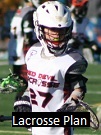Template:Games Based Approach to Coaching Lacrosse
From Lacrosse Plan Drills
Games Based Approach to Coaching Lacrosse: The what, why, and how of implementing games based training, to maximize the development of all your lacrosse athletes
TJ Buchanan (World Lacrosse) - 10/21/2021
Implementing Small Area Games
- Thought on how we coach rather than what to coach
- Replicates a part or multiple parts of the bigger game
- Typically played in a space smaller than full sized playing surface
- Requires less participants than the full game
- Ideal world, have multiple stations of small area games, and a coach moves throughout stations
- Use the term "games" instead of "drills"
Why are small area games important?
- Can maximize opportunity for participation in training sessions
- Encourage sport IQ development
- Promote sport skill development in Context
- Prepares the athlete for a variety of situations, including the unknown
- Develop creativity and decision making
- Allow the coach to provide athletes with appropriate challenge to each athlete
Drill: Have One / Need One
- Count the number of kids
- Add balls equal to half of the number of kids
- Everyone talks and says "Have one" or "Need one" - to either pass or receive a pass
- Lots of movement, try to pass or receive from a new guy
Game Design
- Rules - Dictate the actions of the athletes to arrive at a predetermined outcome
- Give you control, to help the players get to a specific outcome
- Constraints - influence the actions of the athletes, but allow them to control the ultimate outcome
- Help develop Lax IQ
Drill: King of the Ring
- 3v3 with goals on each side (soccer circle is good size)
- Play to 5-7 goals, losing team stays on the field and plays on-deck team
- Variation: add a "bonus" area where goals are worth an extra point
- Variation: Offense must set a pick to score
- Variation: Defense must double the ball
Coaching during Small Area Games
- Provide questions not solutions to the athlete (tone is important)
- When <blank> happened why did you <blank>?
- When the ball got turned over in the fast break, why did you pass it to the point attackman?
- What other options were available to you? -If no answer, coach needs to work on better scanning or just hold onto the ball
- If you could do it again, what would you have done different?







